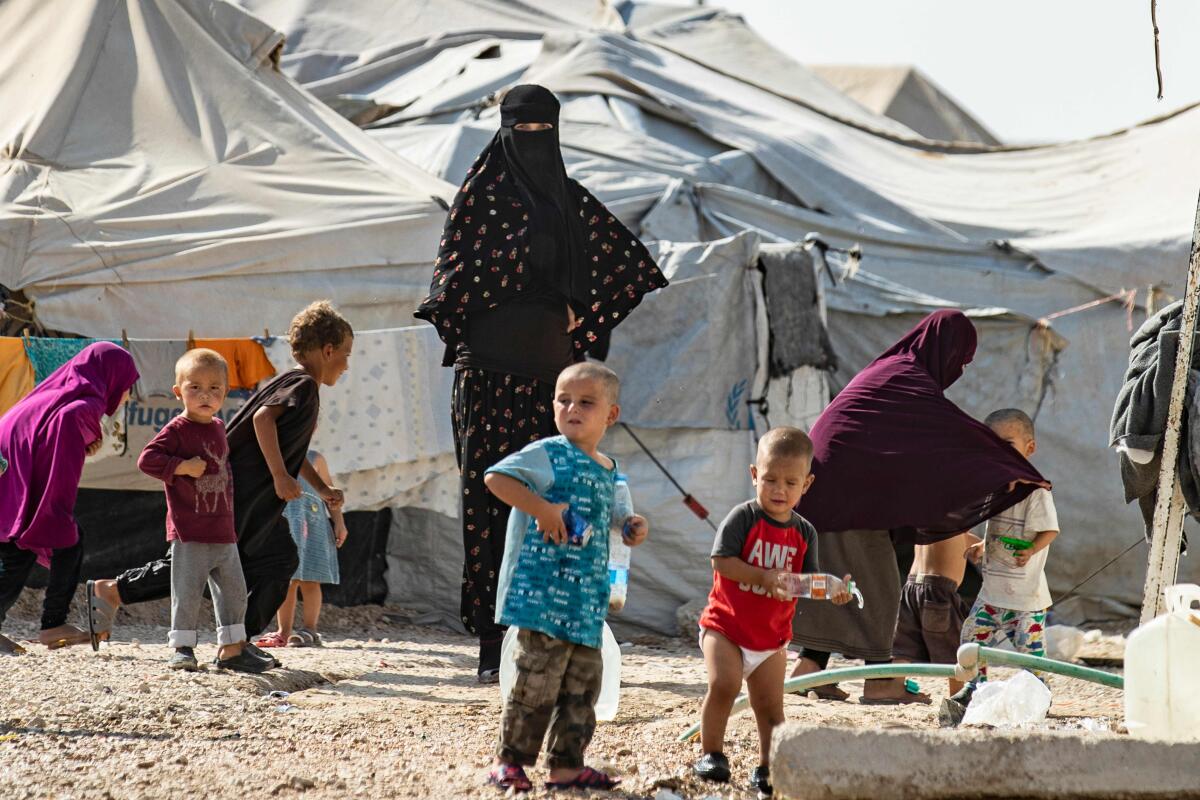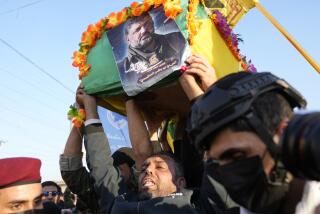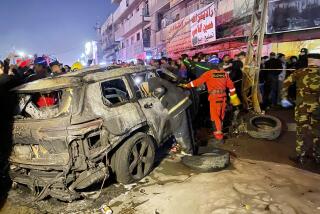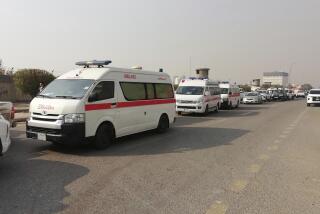Will the demise of Abu Bakr Baghdadi also be the end of Islamic State?

“Our emir is not dead!” shouted a bespectacled Egyptian woman from behind a chain-link fence. “This is propaganda! We don’t believe it!”
“More American lies,” said another woman, who spoke with a French accent but would not say what country she was from.
The women, who wore black veils and cloaks from head to toe and would not give their names, are among 70,000 detainees at a camp in northeastern Syria — all relatives of Islamic State fighters who were dead or in jail.
They bridled at the notion that Abu Bakr Baghdadi, the leader of Islamic State, had been killed Saturday in northwestern Syria in a U.S. raid — a reported development that was celebrated in Washington, Europe and much of the Middle East and raises existential questions about the group’s future.
Sheep grazed outside the fencing encircling the sun-baked detention camp, which is guarded by Kurdish troops, who often exchange taunts with their charges.
The camp administration, fearing further unrest in an already unstable environment, shut down the internet at the camp Sunday as news began to spread of Baghdadi’s demise. Officials also restricted the access to journalists, explaining that the situation at the camp was more volatile than usual.
“We don’t want the people to be any more agitated,” said Elol Rizgar, a Kurdish fighter and one of the camp administrators. “We want to maintain calm as much as possible.”
Children playing outside canvas tents with blue United Nations’ lettering greet visitors with a raised index finger — an Islamic State gesture threatening death.
Few doubt that the reported death of Baghdadi is a devastating symbolic blow to Islamic State.
He loomed smaller in the American psyche than Osama bin Laden, the architect of the Sept. 11 terrorist attacks. But it was under his reign that an exhausted insurgency in Iraq metastasized into the world’s most notorious terrorist group.
“This is a man who built a whole, as he would like to call it, ‘a country,’ a caliphate, and was trying to do it again,” President Trump told reporters Sunday.
A plump-faced religious scholar from Iraq, Baghdadi was detained during the U.S. invasion there in 2003 and held at a U.S.-run detention center for 11 months before being released.
Few in the world had heard of him — fewer still had ever seen him — when Baghdadi plodded up to the pulpit of the Great Nuri Mosque in 2014, in the Iraqi city of Mosul, and declared himself the “Emir” or head of the Faithful.
His reign was marked with bouts of genocidal re-engineering of communities that didn’t fit his vision for a Sunni Muslim state.
Islamic State conducted a systematic erasure of the Yazidi people, massacring the men, placing the women in sexual slavery and indoctrinating the children to be future extremists.
Elsewhere, the group’s fighters launched attacks so ferocious that enemies shed their uniforms and ran away.
Millions suffered under Baghdadi’s blood-drenched rule. At its zenith, his caliphate extended across a third of both Iraq and Syria, with tens of thousands of fighters from dozens of countries.
In the meantime, the group entrenched itself in the running of state affairs, cajoling or threatening those working in public institutions to yield to its cause. It also constructed a network of informers and enforcers.
Rival campaigns, one by the U.S.-led coalition, another led by Russia, began to take back territory from the caliphate in 2015 and by this year the group had lost nearly all of it and reverted to its old strategy of launching terrorist attacks.
U.S. and Iraqi military officials have described the group’s remnants as little more than a criminal gang, reduced to conducting gadfly attacks in sparsely populated areas where its fighters can easily hide.
Even after Islamic State began to suffer defeats, the elusiveness of Baghdadi helped give the group an aura of invincibility.
The United States placed a $25-million bounty on s his head, turning him into one of the world’s most wanted men.
Every year would bring fresh boasts that he had been killed or incapacitated. Sensational news reports would speak of near-misses, with rumors of a black-clad sheik departing from an area just before it was bombed or overrun.
Baghdadi would always show up again, commenting on regional developments in audio and video messages, while urging his adherents to keep attacking what he called the “Crusaders” and their “lackeys.”
Though many Muslims rejected his labeling himself a caliph, among his followers he gained a special position, said Hisham Hashimi, an Iraqi researcher of extremist groups.
“No one could join the caliphate without pledging allegiance to Baghdadi,” Hashimi said
What has never been clear, however, is what practical role he held in Islamic State’s commanding structure — a mystery at the heart of what now happens to Islamic State.
In one scenario, Baghdadi had become the group’s play master, so essential that it will not be able to function without him.
That seemed to be the message of his last video, released in April 2019, in which masked operatives come to his side to give him folders with briefings on the group’s global operations.
“The organization wanted to give the impression he was overseeing everything,” said Aymenn Jawad Tamimi, an analyst who studies Islamic State documents.
But there is another scenario in which Baghdadi matters far less. Tamimi said that Islamic State defectors have described Baghdadi as a distant figure, often difficult to contact and slow to respond to advice or consultations.
In this version of the future, his ideology lives on, inspiring terrorists around the world to continue his project.
Proponents of this view point to Islamic State’s return to its guerrilla roots, which has made the group’s leadership only more diffuse.
“Daesh’s authority is a horizontal hierarchy much more than a vertical one,” Hashimi said, referring to the group by its Arabic acronym. “It won’t end even with the death of all of its leaders.”
U.S. coalition commanders also warn that though the group has suffered large losses in the past, it had still mounted a return once military pressure was reduced, allowing it to operate in the seams between ill-coordinated security forces.
That seems more likely with Trump’s on-again off-again withdrawal from Syria. Islamic State feeds on turmoil, and already a Turkish-led invasion has fractured the delicate — and ultimately unsustainable — security arrangements the U.S. had forged with Kurdish-led militias.
If there is a more complete break, a shadow army of Islamic State detainees, estimated to number some 12,000 fighters and tens of thousands of their family members, would be ready to heed the call of a new leader.
Who that would be is unclear. Tamimi mentioned a figure known as Hajj Abdullah, who in documents and communiques emerges as Baghdadi’s deputy.
As of Sunday, Islamic State had not acknowledged the death of Baghdadi. Its channels on social media did not even mention him.
Instead they highlighted Islamic State attacks in Iraq, Syria and Afghanistan.
McDonnell reported from Al Hol and Bulos from Beirut.
More to Read
Start your day right
Sign up for Essential California for news, features and recommendations from the L.A. Times and beyond in your inbox six days a week.
You may occasionally receive promotional content from the Los Angeles Times.






